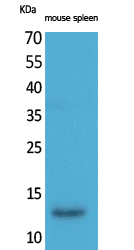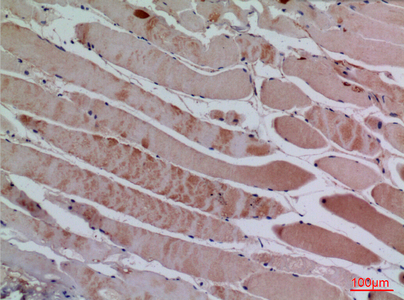BLC Polyclonal Antibody
- Catalog No.:YT5208
- Applications:WB;IHC;IF;ELISA
- Reactivity:Human;Mouse
- Target:
- BLC
- Fields:
- >>Cytokine-cytokine receptor interaction;>>Viral protein interaction with cytokine and cytokine receptor;>>Chemokine signaling pathway
- Gene Name:
- CXCL13
- Protein Name:
- C-X-C motif chemokine 13
- Human Gene Id:
- 10563
- Human Swiss Prot No:
- O43927
- Mouse Swiss Prot No:
- O55038
- Immunogen:
- The antiserum was produced against synthesized peptide derived from the Internal region of human CXCL13. AA range:41-90
- Specificity:
- BLC Polyclonal Antibody detects endogenous levels of BLC protein.
- Formulation:
- Liquid in PBS containing 50% glycerol, 0.5% BSA and 0.02% sodium azide.
- Source:
- Polyclonal, Rabbit,IgG
- Dilution:
- WB 1:500 - 1:2000. IHC: 1:100-300 ELISA: 1:20000.. IF 1:50-200
- Purification:
- The antibody was affinity-purified from rabbit antiserum by affinity-chromatography using epitope-specific immunogen.
- Concentration:
- 1 mg/ml
- Storage Stability:
- -15°C to -25°C/1 year(Do not lower than -25°C)
- Other Name:
- CXCL13;BCA1;BLC;SCYB13;C-X-C motif chemokine 13;Angie;B cell-attracting chemokine 1;BCA-1;B lymphocyte chemoattractant;CXC chemokine BLC;Small-inducible cytokine B13
- Observed Band(KD):
- 15kD
- Background:
- C-X-C motif chemokine ligand 13(CXCL13) Homo sapiens B lymphocyte chemoattractant, independently cloned and named Angie, is an antimicrobial peptide and CXC chemokine strongly expressed in the follicles of the spleen, lymph nodes, and Peyer's patches. It preferentially promotes the migration of B lymphocytes (compared to T cells and macrophages), apparently by stimulating calcium influx into, and chemotaxis of, cells expressing Burkitt's lymphoma receptor 1 (BLR-1). It may therefore function in the homing of B lymphocytes to follicles. [provided by RefSeq, Oct 2014],
- Function:
- function:Chemotactic for B-lymphocytes but not for T-lymphocytes, monocytes and neutrophils. Does not induce calcium release in B-lymphocytes. Binds to BLR1/CXCR5.,online information:CXCL13 entry,similarity:Belongs to the intercrine alpha (chemokine CxC) family.,tissue specificity:Highest levels in liver, followed by spleen, lymph node, appendix and stomach. Low levels in salivary gland, mammary gland and fetal spleen.,
- Subcellular Location:
- Secreted.
- Expression:
- Highest levels in liver, followed by spleen, lymph node, appendix and stomach. Low levels in salivary gland, mammary gland and fetal spleen.
- June 19-2018
- WESTERN IMMUNOBLOTTING PROTOCOL
- June 19-2018
- IMMUNOHISTOCHEMISTRY-PARAFFIN PROTOCOL
- June 19-2018
- IMMUNOFLUORESCENCE PROTOCOL
- September 08-2020
- FLOW-CYTOMEYRT-PROTOCOL
- May 20-2022
- Cell-Based ELISA│解您多样本WB检测之困扰
- July 13-2018
- CELL-BASED-ELISA-PROTOCOL-FOR-ACETYL-PROTEIN
- July 13-2018
- CELL-BASED-ELISA-PROTOCOL-FOR-PHOSPHO-PROTEIN
- July 13-2018
- Antibody-FAQs
- Products Images

- Western Blot analysis of mouse spleen cells using BLC Polyclonal Antibody. Secondary antibody(catalog#:RS0002) was diluted at 1:20000

- Immunohistochemical analysis of paraffin-embedded human-muscle, antibody was diluted at 1:100

- Western blot analysis of lysate from mouse spleen cells, using CXCL13 Antibody.



